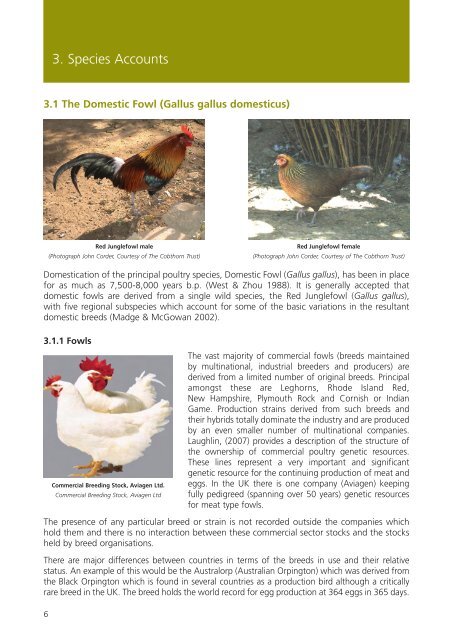Poultry in the United Kingdom - Defra
Poultry in the United Kingdom - Defra
Poultry in the United Kingdom - Defra
Create successful ePaper yourself
Turn your PDF publications into a flip-book with our unique Google optimized e-Paper software.
3. Species Accounts<br />
3.1 The Domestic Fowl (Gallus gallus domesticus)<br />
6<br />
Red Junglefowl male<br />
(Photograph John Corder, Courtesy of The Cobthorn Trust)<br />
Red Junglefowl female<br />
(Photograph John Corder, Courtesy of The Cobthorn Trust)<br />
Domestication of <strong>the</strong> pr<strong>in</strong>cipal poultry species, Domestic Fowl (Gallus gallus), has been <strong>in</strong> place<br />
for as much as 7,500-8,000 years b.p. (West & Zhou 1988). It is generally accepted that<br />
domestic fowls are derived from a s<strong>in</strong>gle wild species, <strong>the</strong> Red Junglefowl (Gallus gallus),<br />
with five regional subspecies which account for some of <strong>the</strong> basic variations <strong>in</strong> <strong>the</strong> resultant<br />
domestic breeds (Madge & McGowan 2002).<br />
3.1.1 Fowls<br />
Commercial Breed<strong>in</strong>g Stock, Aviagen Ltd.<br />
Commercial Breed<strong>in</strong>g Stock, Aviagen Ltd<br />
The vast majority of commercial fowls (breeds ma<strong>in</strong>ta<strong>in</strong>ed<br />
by mult<strong>in</strong>ational, <strong>in</strong>dustrial breeders and producers) are<br />
derived from a limited number of orig<strong>in</strong>al breeds. Pr<strong>in</strong>cipal<br />
amongst <strong>the</strong>se are Leghorns, Rhode Island Red,<br />
New Hampshire, Plymouth Rock and Cornish or Indian<br />
Game. Production stra<strong>in</strong>s derived from such breeds and<br />
<strong>the</strong>ir hybrids totally dom<strong>in</strong>ate <strong>the</strong> <strong>in</strong>dustry and are produced<br />
by an even smaller number of mult<strong>in</strong>ational companies.<br />
Laughl<strong>in</strong>, (2007) provides a description of <strong>the</strong> structure of<br />
<strong>the</strong> ownership of commercial poultry genetic resources.<br />
These l<strong>in</strong>es represent a very important and significant<br />
genetic resource for <strong>the</strong> cont<strong>in</strong>u<strong>in</strong>g production of meat and<br />
eggs. In <strong>the</strong> UK <strong>the</strong>re is one company (Aviagen) keep<strong>in</strong>g<br />
fully pedigreed (spann<strong>in</strong>g over 50 years) genetic resources<br />
for meat type fowls.<br />
The presence of any particular breed or stra<strong>in</strong> is not recorded outside <strong>the</strong> companies which<br />
hold <strong>the</strong>m and <strong>the</strong>re is no <strong>in</strong>teraction between <strong>the</strong>se commercial sector stocks and <strong>the</strong> stocks<br />
held by breed organisations.<br />
There are major differences between countries <strong>in</strong> terms of <strong>the</strong> breeds <strong>in</strong> use and <strong>the</strong>ir relative<br />
status. An example of this would be <strong>the</strong> Australorp (Australian Orp<strong>in</strong>gton) which was derived from<br />
<strong>the</strong> Black Orp<strong>in</strong>gton which is found <strong>in</strong> several countries as a production bird although a critically<br />
rare breed <strong>in</strong> <strong>the</strong> UK. The breed holds <strong>the</strong> world record for egg production at 364 eggs <strong>in</strong> 365 days.

















